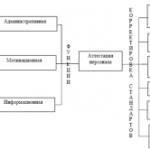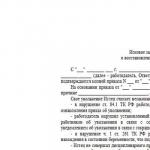We analyze the demand for products. Step-by-step instructions on how to conduct a demand analysis How to investigate the demand for products
The world's leading brands invest large sums in marketing research, the results of which largely influence the adoption of key management decisions. The cost of such studies starts from 60,000 rubles and more - cosmic sums, especially for small businesses. However, knowing how to analyze the market, you can extract key information yourself.
Kinds
First of all, you need to clearly define goals. The subject of research depends on what kind of information you want to receive. The main structural components of the market analyzed by the entrepreneur are:
- state of the market (capacity, conjuncture, trends, reaction to new products);
- share of different companies in the market, their opportunities and prospects;
- target segments, their behavior and requirements for the product, the level of demand;
- the price level and rate of return in the industry;
- free niches in which you can do business;
- competitors, their strengths and weaknesses.
Speaking about how to properly analyze the market, it is worth emphasizing that a specific, understandable goal allows you to reduce costs, not waste time processing useless information and immediately choose the most effective research methods.

General market analysis plan
Comprehensive marketing research is usually carried out at the stage of starting or expanding a business. Its goal is to collect as detailed and comprehensive information about a particular niche as possible. How to analyze the market?
Stage 1: Gathering basic information
The "starting point" in conducting a comprehensive analysis is Market Research (actually, studying the market and its prospects). Ideally, it is necessary to analyze the information for the last 3-5 years.
The key indicator here is market capacity. In simple terms, this is the amount of goods that consumers can buy in a certain period of time - a month or a year. For calculations, the formula is used:
| V=A×N |
where: V is the size of the market, A is the size of the target audience (thousand people), N is the rate of product consumption for the period.
Based on this indicator, it is calculated what maximum level of sales a company can achieve in a given region.
The next criterion to pay attention to is the level of demand. It is important to take into account the dynamics of the market, whether it is developing or, on the contrary, declining. In the first case, it is necessary to determine its potential and the boundaries of growth, and at the stage of stagnation, to understand how long this will continue.
In addition, they study the factors affecting the market, the share of key competitors in the total sales volume, and the ways of selling products.
Based on the data obtained, it is necessary to identify the main trends and directions of development, as well as analyze the market prospects - what consumers are choosing now and how their preferences may change in the foreseeable future.
Tip: Up-to-date statistics and research results of individual markets at the international and national levels can be found in trade journals and economic reports.

Stage 2: Identification of target segments
So, we know the volume of the analyzed market as a whole. Now it is necessary to determine which groups of consumers bring the company the main profit, what unites them. Different criteria are used to segment the audience - gender, age, profession, income level, social status, interests, etc. Depending on the priorities, the significance of individual factors may differ.
To decide which segments to focus on in the first place, they additionally analyze:
- volume of each segment (number of potential customers);
- geographical location;
- availability of various consumer groups;
- Estimated costs of time and finances to start the activity.

A competent choice of target audience in the future will save the entrepreneur from unnecessary costs and will allow directing resources to attract the most "profitable" buyers.
Stage 2: Study of external factors
Any market is constantly exposed to outside influences. Modern marketers identify 6 types of external factors that affect organizations:
- political (state policy in the areas of transport, employment, education, etc., taxes);
- economic (inflation rate, loan interest rate);
- social (population, worldview, level of education);
- technological;
- legal (laws regulating the creation and operation of enterprises);
- ecological.
Some trends appear slowly, they are easy to predict - for example, back in the 70s, people began to discuss the problems of protecting the environment, and now eco-friendly business has become a global trend. At the same time, the economic situation can change at any moment, and it is simply impossible to say with certainty what will happen in 3-5-10 years.

Stage 4: Analysis of competitors
Speaking about how to learn how to analyze the market, special attention should be paid to the study of enterprises that are already operating in this industry. First of all, you need to learn as much as possible about the companies themselves and their capabilities:
- technologies that are used in the production of goods and services;
- availability of patents and unique technological advantages;
- staff qualification level;
- access to limited, scarce resources;
- opportunity for additional investment.
The next step is to study the products and services of competitors. It is necessary to evaluate "through the eyes of the consumer", taking into account both rational and emotional factors.

It remains to systematize the data and objectively compare the main market players. For convenience, we suggest using a simple template.
By filling out the table, you will get a basic understanding of the main market players and their activities, as well as be able to compare their performance with your own.

Stage 5: Price Analysis
To see the full picture, it is necessary to break down all market players into price segments - economy, premium, etc. It is also important to understand the price structure (cost, promotion and advertising costs, markup) and approximately calculate the profit from each sale.
Any price set by the seller will somehow affect the level of demand for the product.
The demand curve shows how many goods will be sold on the market during a specific period of time at different prices. In a normal situation, demand and price are inversely proportional, that is, the higher the price, the lower the demand; the lower the price, the higher the demand. So, by raising the price, the company will sell a smaller quantity of goods. Consumers on a tight budget, faced with a choice of alternative products, will buy less of those that are too expensive for them.
Foreign firms are constantly measuring changes in demand depending on price changes, this indicator is the main one in the ongoing pricing policy. Differences in approaches to measurements are dictated by the type of market. Under conditions of pure monopoly, the demand curve indicates that the demand for a product is justified by the price that the company asks for it. However, with the advent of one or more competitors, the demand curve will change depending on the competitors' prices.
The sensitivity of demand to price changes is characterized by the elasticity index. Elasticity measures the percentage change in one variable as a result of a 1% change in another variable.
If, under the influence of a small change in price, demand almost does not change, then it is inelastic. If at the same time demand undergoes significant changes, then it is considered that it is elastic.
General demand for many manufactured goods is characterized by low price elasticity. What determines price elasticity of demand? Demand is likely to be less elastic under the following circumstances: 1) there is little or no substitute for the product, or there are no competitors; 2) buyers do not immediately notice the price increase; 3) buyers are slowly changing their shopping habits; 4) buyers believe that the increased price is justified by the improvement in the quality of the goods, the natural increase in inflation, etc. If demand can be defined as elastic, sellers should think about lowering the price. A lower price will bring more total revenue. And this approach makes sense as long as there is no disproportionate increase in the costs of production and marketing of goods.
In the practice of foreign firms, a numerical (calculated) assessment of the elasticity of demand (supply) depending on price changes is widely used.
If we designated the quantity of demand (supply) as q, and the price of the goods - P, then the indicator (coefficient) of demand (supply) depending on the change in price, or the price elasticity of demand (supply), Ep will be equal to:
where Aq and Ap - change in demand (supply) and prices. %.
Example 1. The price of a product increased by 10%, the demand for it decreased by 3%. The elasticity of demand for a good with a change in price is:
Ep = -3/10 = -0.3
Example 2. The price of a product increased by 10%, the supply (production) of the product increased by 1%. The elasticity of the supply of a product with a change in price is:
Ep > 1 - demand is elastic;
Ep = 1 - demand with unit elasticity.
Positive values of elasticity reflect equally directed changes in interrelated quantities: both increase and both decrease; negative - different directions of changes: one value increases, the other decreases, or vice versa, one decreases, the other increases.
Price elasticity of demand is usually negative, while supply elasticity is usually positive.
Indicators of the elasticity of demand (supply) are widely used by foreign enterprises when setting prices for goods.
First of all, knowing the elasticity of demand for a product put on the market, the entrepreneur has the opportunity to determine in advance the reaction of buyers to a change in price.
In addition, the elasticity indicator serves as a measure in assessing trends in the total costs of the enterprise, depending on the nature of the demand for the product.
Knowing the price elasticity of demand, one can quite simply calculate a number of indicators necessary for entrepreneurial activity, in particular, a possible price change.
It is quite obvious that with an increase in the volume of sales of a product (for example, an entrepreneur has expanded its market share or intends to expand it), using the elasticity coefficient for the product being sold, a possible price change can be calculated.
The elasticity indicator is widely used for price forecasting. At the same time, it should be noted that the demand for individual groups of goods reacts differently (with different elasticity) to price changes. For many goods, the demand for them is usually the more elastic the longer the time period for making a decision. For some goods, demand may be more elastic in the short run.
Studies of demand for gasoline and automobiles conducted in the United States showed that for these two factors, the elasticity coefficients depending on the duration of the period of change in prices and incomes are opposite: for gasoline in the long run, the coefficient of elasticity of demand in absolute terms is greater than in the short run, and for cars - vice versa.
Thus, the study of demand is a very important and necessary part of the pricing methodology. At foreign enterprises, this issue is given exceptional importance, since supply and demand are the two main levers of a market economy.
In support of the importance of elasticity of demand, the following example from business practice.
Hello dear reader! I am glad to welcome you to the vastness of our business magazine.
Recently, my colleagues and I thought about the question of what is the most popular product in Russia. I think every thinker sooner or later comes up with this question. Personally, he began to torment me from the moment we decided to launch our online store, but that's another story.
Usually one question causes a series of subsequent ones, so today there will be not only the top-selling goods in Russia, Ukraine and the CIS - we will also consider with you:
- trending goods in online sales;
- what is in demand on bulletin boards (www.avito.ru);
- top 10 purchased goods worldwide;
- what is currently being bought by the Slavic brother in China (using the resource ru.aliexpress.com).
Purpose of this article- general development, expansion of consciousness. You will learn how to analyze the demand for a product and its seasonality using public Internet tools, and most importantly, you will be able to show off your new knowledge to your comrades. Let's start!
The best-selling product in Russia and Ukraine
This information is unlikely to help you find a niche for your store, but at least it is interesting. You have a minute to think for yourself which product is the best-selling in Russia.
And no, the answer is not food, not cigarettes, and not even alcohol, but we buy it almost every time we go shopping to the store or to the market. In general, the purchase of this product occurs on the machine. Guessed?
So, the title of the best-selling product in Russia is the usual plastic bag. Even on such a seemingly insignificant product, you can make millions of rubles.

The world has already begun to realize that polyethylene products cause great harm to the environment. The problem is that polyethylene does not decompose for a long time, and this leads to the death of 1 million birds, 100,000 marine mammals and a huge number of schools of fish. In the US and Europe, plastic bags began to be abandoned.
What to look for when choosing a product for sale?
If you are interested in a product for sale, you should go the other way. You should not look for the most popular product that is bought by the population in “cars”. First of all, we need to look at the prospects and profitability - our product must also be ready for adverse conditions, since economic crises are now not uncommon.
The list of the most purchased goods in Russia includes the following:
- small household appliances;
- electrical goods;
- sanitary goods;
- everyday tools;
- household chemicals;
- clothing and footwear;
- children's products;
- other goods of daily use.
Let's go through the list of the most popular products:
- meat (beef, pork, chicken, turkey);
- semi-finished products;
- chicken eggs;
- frozen seafood (fish);
- vegetable and butter;
- cow's milk;
- flour and pasta;
- sugar and salt;
- Black tea;
- cereals (buckwheat, rice, millet, oats);
- vegetables (potatoes, carrots, onions, cabbage);
- apples, bananas.
 Some have more demand, some less. How to decide?
Some have more demand, some less. How to decide?
- Focus on your interest and think about what is closer to your heart.
- Everything is known in comparison: in order to make a choice in favor of a particular product, analysis is needed (this will be discussed in a separate article).
It is beyond the scope of the article, so we will consider this problem in more detail another time. And now we will begin to rank the most purchased goods by Russians on the Internet. Go!
Top best-selling products on the Internet in 2017
The Internet is a large and interesting market, for three reasons:
- now the Internet coverage in Russia is about 74%, while there is a constant growth;
- the share of users of the older age group is also increasing;
- mobile Internet audience rushes at space speed (30-40% of people access our site from smartphones or tablets).
70% of all Russian Internet users logged in at least once from a mobile device - a year ago, for example, this figure was 56%.
What is the reason for such a rapid growth of the Internet? Along with it, the demand for goods and services is increasing, and this is what we need. Next, we'll look at:
- the most demanded and popular goods in online stores;
- the most trendy and popular products on one-pagers for today.
1. Search for a product in demand for an online store
In an attempt to keep track of the most popular and popular products in online stores that are best bought by the population in 2016, we came up with the following top 10 list.
- Small household appliances today are the leader in online sales. The low price and compact dimensions make this product almost ideal (but this product is not suitable for sale in your online store).
- Perfumes and cosmetics .
- Mobile devices.
- Laptops and tablets.
- Internet gifts and toys.
- Licensed software.
- Clothing and footwear.
- Books. Surprisingly, paper books are still popular. It would seem that they are expensive, besides, there are many sites where you can download literature of interest in electronic form for free. However, this does not prevent paper books from being sold.
- Booking tickets online. You can’t imagine how many planes are in the air right now (whenever you have a free moment, go to flightradar24.com - this will expand the boundaries of your consciousness).
- Large home appliances.

Most of the listed products will not work if you are going to open an online store from scratch. Problems and breakdowns can arise with equipment, and in order to earn normally, you need to order in bulk. It is unrealistic to compete with big players who take goods in bulk and sell them at a price typical for ordinary stores.
2. One-pager: what is it and why is it needed?
One-pager, landing page, landing page, landing page - these are all synonyms.
There is such a category as wow-goods (in Russian wow = wow) - goods of impulse demand. Have you ever walked past a store or kiosk, saw an advertisement for a product on TV or the Internet, and you immediately wanted to buy it, although before that you didn’t even know it existed? It is highly likely that this was a product from this category. TV stores also often sell wow goods. Here are some examples:
- effortless slimming belt;
- simulators that pump muscles without your participation;
- all kinds of savers of water, light, fuel, etc.;
- creams to increase something;
- copies of branded watches, iPhones.
Are you familiar with the concept of CPA networks, affiliate marketing and traffic arbitrage? If not, this will be a separate detailed article. In short, a CPA network is an intermediary between a webmaster (a person who works with sites and traffic) and advertisers who have a product. They are ready to pay a commission to the webmaster for promoting and selling the product. CPA networks sell wow products through one-pagers. Remember the phrase that demand creates supply? In the case of these guys, it's the other way around.
Here is one of the many Pater networks - //m1-shop.ru/. After registration, the offered goods will be available at the link //m1-shop.ru/offers, which you can familiarize yourself with (about 300 offers). I will give 10 of them, which were top at the time of this writing.
So, your attention is presented to the top of the most popular products that are sold through one-pagers in large volumes.
- Mask from black dots and acne Black Mask.
- Solar power bank.
- Army wrist watch Amst.
- AB Gymnic belt.
- MAC corrector.
- Corset Waist Trainer.
- Mangosteen is a slimming syrup.
- FishHungry Biting Activator.
- Spray for hair Ultra Hair System.
- titanium gel.
Some data from Avito - the largest bulletin board in Russia
I tried to find information for 2016, but only came across the official report from two years earlier. Since there is fish for lack of fish and cancer, we will continue to talk about 2014. However, the information is interesting and useful, so there will be something to think about.
Conducting a study, Avito analysts found that site users were stingy with 34.4 billion rubles in product categories such as:
- personal items;
- goods for home and garden;
- hobbies and recreation;
- Appliances;
- goods for pets.
 A third of the turnover was taken over by the categories “Personal belongings” and “Products for home and summer cottages” (6.5 and 5.5 billion rubles, respectively). Funny thing: Compared to the previous year, sales in these categories grew almost equally - by 38.6% and 38.3%.
A third of the turnover was taken over by the categories “Personal belongings” and “Products for home and summer cottages” (6.5 and 5.5 billion rubles, respectively). Funny thing: Compared to the previous year, sales in these categories grew almost equally - by 38.6% and 38.3%.
And the best-selling category of goods was "Consumer Electronics": laptops, computers, video and photo cameras, smartphones and other gadgets were sold on Avito for 15.2 billion rubles. The amount is not small, but if compared with the previous year, the growth is only 13.2%.
3.5 billion rubles were spent on Hobby and Leisure, an increase of 47.4%. And they did not spare money on pets and spent 4.7 billion rubles: the annual growth was as much as 82%.
- fan;
- netbook;
- swimsuit;
- smartphone;
- prom dress;
- tent;
- Yorkshire Terrier;
- video card;
From this list, we can conclude that the demand is strongly influenced by the season.
How to analyze the seasonality of a product?
If you are reading this article because you are going to open an online store or start a business, it is important not to miscalculate the seasonality of the product.
Let's look at a product that is at the beginning of the top on Avito - a fan.
To analyze seasonality and demand, we will use the well-known service https://wordstat.yandex.ru/. It is designed to evaluate the user interest that can be applied to the product we have selected. Before starting work, you must register / log in to the service. If you don't want captcha popping up all the time, it's better to immediately disable adblock or its equivalent.
Next, we select the region that interests us (in my case, I look at data for Russia, Ukraine and other CIS countries). Next, in a special field, I enter the query “buy a fan”, as it more accurately reflects the intention of users than just “fan”.

The service shows that for the last month there were 236,554 impressions for this query (wow, not bad!). It can be concluded that the product is in demand. And I'll check the seasonality of this product! I just did a search for "By words", now I'll switch the checkbox to "Query History" and see what happens. The graph shows that in 2016 the demand for fans increased by 2 times compared to last year (apparently this year is VERY hot). Thus, if you bought fans and started selling them in the winter, most likely nothing would come of it. Therefore, never buy a product without testing the demand!

Of course, the example I gave is obvious - it is clear that it is hot in summer, and the demand for fans will be greater than in the cold season. However, not all products are so obvious. It is also better to look for such niches where the chart is just starting to rise - it is better to prepare for the season in advance.
Rating of the most popular goods from China
It is difficult to determine the sales leader of the Chinese market, because it buys anything and in huge quantities. Have you ever ordered something from China? Personally, I ordered a watch, a scale, an e-book case, a bag, a UV lamp, and all sorts of other things. If anyone does not know, here are 2 sites where the bulk of the population of Russia, Ukraine and the CIS orders goods from China:
- Aliexpress is more designed for retail purchase - here you can easily order goods in one copy. However, sometimes it is more profitable to buy goods in a regular online store than here.
- Alibaba is a large wholesaler: prices for goods are much cheaper, but you have to order in bulk. Often the delivery of goods is several times more expensive than its cost.
- Cell phones;
- clothing and footwear, including copies of world brands;
- laptops and tablets;
- Appliances;
- computer components and accessories;
- goods for sports and recreation;
- bedding;
- furniture;
- electrical goods;
- equipment and machines.
Of course, the data does not reflect reality 100%, but the truth is somewhere nearby.
For women



For men



For kids



Electronics

Flash credit card

Waterproof case for iPhone

Convenient wallet for iPhone
Sport

We will find out if there is a demand for a product after you compose (read in the article) and you will need to test it (read about ways to test a niche in the article). One of the most common ways to find out demand and demand for goods on the Internet are Yandex wordstat, google adwords and rambler adstat services. We will check our product, which we will sell on the Internet, so we look at availability of demand online.
Since there is only one way, and there are three services (they are all made according to the same principle), we will consider Yandex as an example. For other services, the actions will need to be performed the same, the design of the resource itself will simply be different. Here, the main thing for us is to understand the very principle of action, on which it is worth "focusing attention."
How we will check the demand and the availability of demand for the product.
Step-by-step instruction:
- Open the site www.wordstat.yandex.ru in your browser. After that, you will see this page

- Let's start by choosing the region in which we plan to sell our product. So we'll watch demand and demand not around the world, but in a specific region (because we are not going to sell worldwide yet 😎). So, in order to select a specific region, we click on the button "all regions", which is on the right, just below the input line (as shown in the figure). Select Russia or another region where you are going to sell.

- After choosing a region, you need to enter your key query (product name) in the search box, and also substitute the words "buy .." and "online store ..". For example, "buy a bag" or "online store of bags". Next, click on the button "pick up". Below you will see a list of keywords and the number of impressions per month.
 It is important to note here that not all requests are suitable for us. Naturally, you need to look only at relevant queries. If your product requests 3000-5000 people / month or more, then the product is in good demand. If less, then there may be 2 reasons for this:
It is important to note here that not all requests are suitable for us. Naturally, you need to look only at relevant queries. If your product requests 3000-5000 people / month or more, then the product is in good demand. If less, then there may be 2 reasons for this:
- the product is exclusive (or it is simply rarely bought, such as massage chairs),
- the product is not in demand, which means it is worth reviewing and choosing another niche.
If you plan to sell only in a certain city (or region) at the initial stage, you can look at the number of requests for a specific city (region). To do this, click on the button "by region", which is located below the search bar.

You also have the opportunity to check the chart of requests for the previous and current year. This tool will help you understand how seasonal your product is. To do this, you need to click on the button "query history".

From this chart, we can see that sales peak in August and March. It's obvious and understandable :-D.

But you can also notice that the number of requests has increased compared to last year. And this means that the niche develops and does not fade away. If we look at the query "buy a multicooker", we see a different picture (try to analyze it yourself). Thus, after a short analysis, you can find out demand and availability of demand for goods on the Internet.
P.S.: if you have any questions - write in the comments. If you like it, share it with your friends on social media. networks, do not be greedy :-D. And also subscribe to blog updates so as not to miss new articles.
Many people wonder: how to determine the demand for goods and services so as not to fail. To do this, you need to figure out what demand is, what it depends on, how you can determine it online and what are the testing methods. When an idea arises to start a business, I want to know in advance about its relevance and demand, so as not to waste time and money.

Demand and its types
Demand is an indicator of the demand for a product or service in the market among buyers.
It depends on:
- the level of people's interest;
- time;
- prices.
Consider the types of demand according to consumer interest:
- negative - buyers have no desire to purchase a product, service, negative opinion about it, disgust;
- missing demand - ignoring the product / service, indifference to it, lack of desire to acquire;
- latent demand is typical for goods, services that are not on the market, there is a desire to buy, but there is no goods;
- falling demand - a phenomenon that means that interest in a product or service is fading due to the passage of time or high competition;
- irregular demand - appears from season to season, depends on the season, day, month;
- impulsive demand - a purchase is made unintentionally, under the influence of emotions and spontaneous desires;
- full-fledged demand - a normal phenomenon of demand without conditions, when the demand for a product or service corresponds to the supply and sales volume;
- excessive demand - a phenomenon when the desire to purchase a product / service is higher than the supply and the available quantity;
- irrational demand - the consumer needs goods / services that are harmful to the body (alcohol, cigarettes, drugs).
According to the frequency of occurrence, they are distinguished:
- episodic demand - appears sometimes when there is a certain reason;
- periodic demand - occurs in certain periods of need;
- everyday demand - relevant for goods of daily use.
If we consider the dependence of demand on price, then there is:
- elastic demand - changes, depending on changes in pricing policy;
- inelastic demand - unchanged, despite the increase or decrease in prices; relevant for goods necessary for life.

How demand is formed
Demand is influenced by many different factors.
They should be taken into account, even if the definition of demand for a product gives high performance, it is better to look to the future and do not forget about the following parameters:
- Economy: wages of the population, the economic situation in the country, the crisis, the development of production and other niches, rising prices and their dependence, etc.
- Demography: population, gender, age, migration level, characteristics of the composition of the population.
- Public: the development of culture, the interests of society, the cultural and spiritual level of society, traditions and customs.
- Nature and climate: weather, geographical factors, climatic conditions.
- Politics: attitude towards authorities in various areas, draft laws, the situation in the country, etc.
How to determine the demand for goods and services online
With the help of the wonderful Wordstat Yandex service, you can find out the relevance and demand for goods and services. To take advantage of the service, go to the site, type in the search box the area or product you are interested in. Wordstat Yandex will show the number of requests made by users on this topic recently. The higher the indicators, the higher the demand and interest of consumers.
Also, this service is used for SEO-optimization by selecting popular keywords.
The service automatically shows results for all regions, but you can change the settings to a specific one.
Free ways to determine the demand for a product
If the budget is limited or absent, you can use free demand testing methods.
To do this, register on the following sites and the like:
- Avito;
After registration, place an ad about your product or service. To make it noticeable, use a high-quality image, write a detailed description that tells potential buyers about the benefits of your product.
The disadvantage of this method is that the number of ads can be limited, and they quickly merge with hundreds of similar ones. To get to the TOP, you will need to pay for.

Paid ways to determine demand
- register an account on popular resources: Instagram, Vkontakte, Facebook, etc.;
- post high-quality content that reveals the benefits of products, their relevance, build trusting relationships with the audience, make regular posts;
- use targeted advertising within the social network to increase reach and recognition;
- count the number of requests/calls submitted to purchase a product.
It is better to use all methods at once for more coverage. One of the best is to use . This is such a page with information about a product, service and a call to action. You can create it yourself or contact a web specialist.
To learn about it, you need to buy contextual advertising in Google or Yandex.
- Before determining the demand for a product, research the market, competitors, prices. Think about what new you can offer to be competitive.
- Identify your target audience: gender, age, place of residence, interests, lifestyle, income level.
- Do not forget about the influence of seasons, holidays, weather conditions on demand.
- Follow Internet trends, if you use them correctly, you can increase the demand for your products and services.
- Build a strong personal brand. This builds trust with customers, increases awareness and sets you apart from competitors.
Conclusion
To determine the demand for a product, you will have to do promotion, collect applications and calls, analyze data, and spend money on advertising. If you are satisfied with the indicators, then feel free to purchase goods or start providing services. If the numbers do not console and do not inspire motivation to continue, then develop a new idea and repeat the verification algorithm again.






